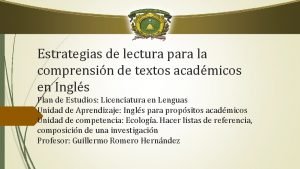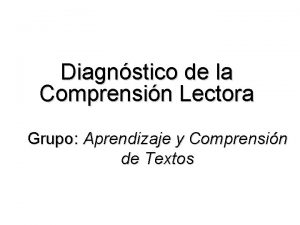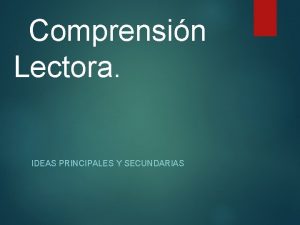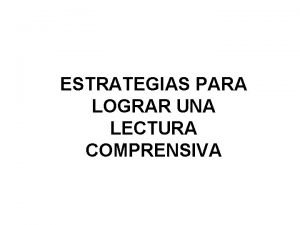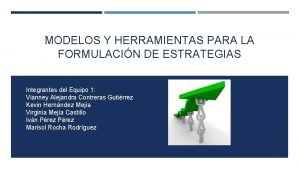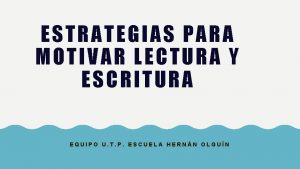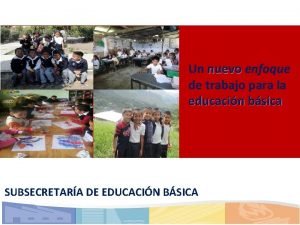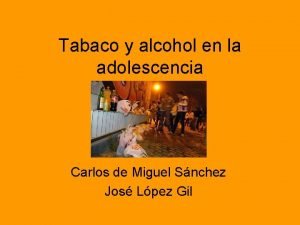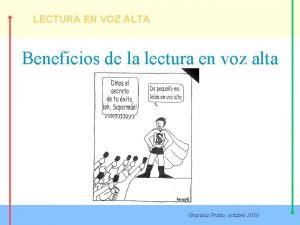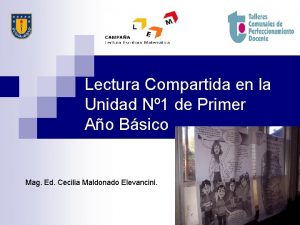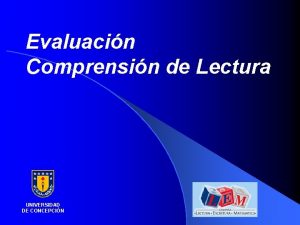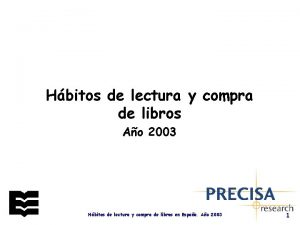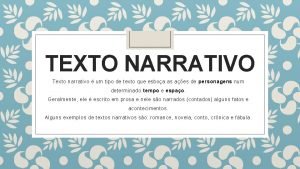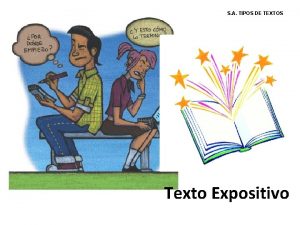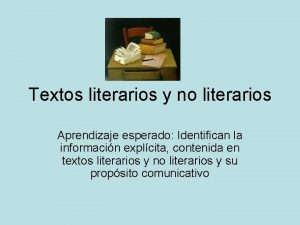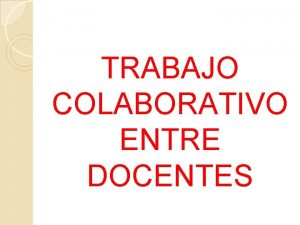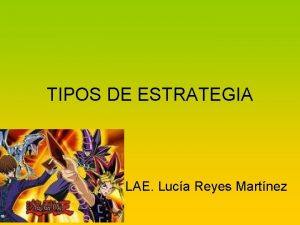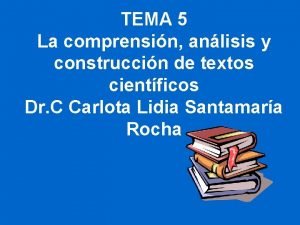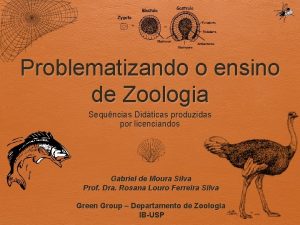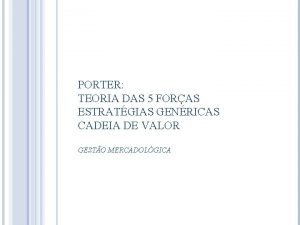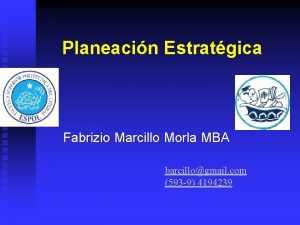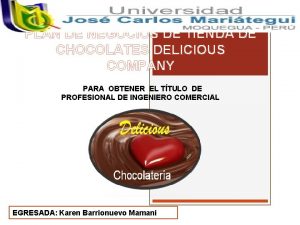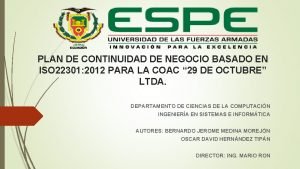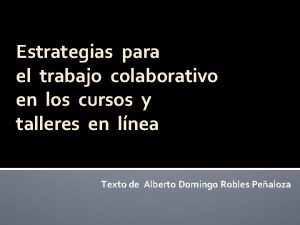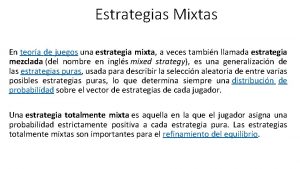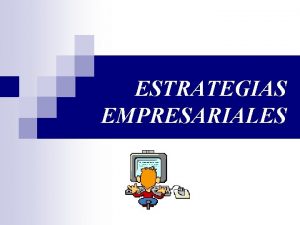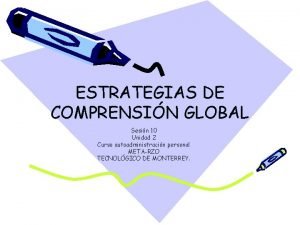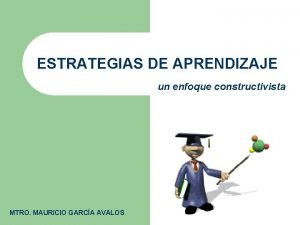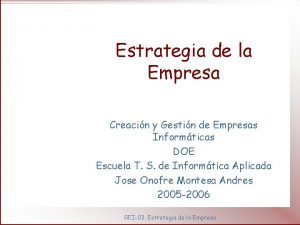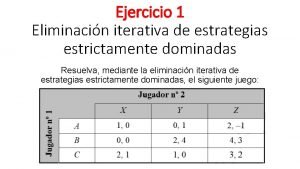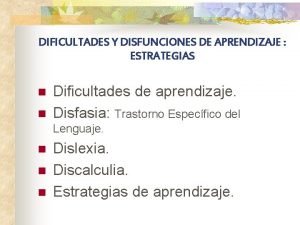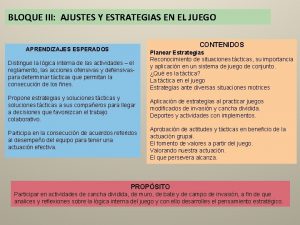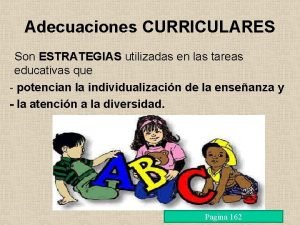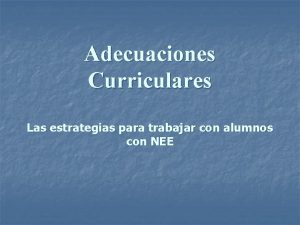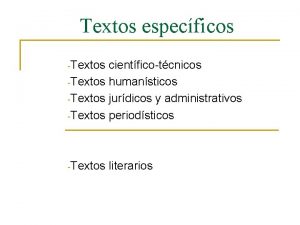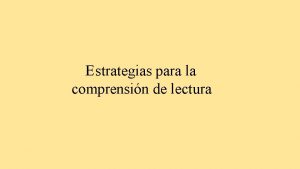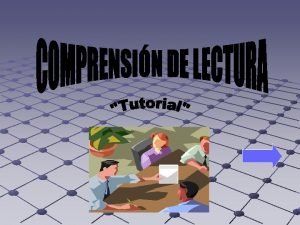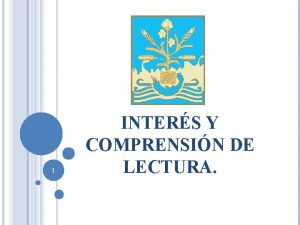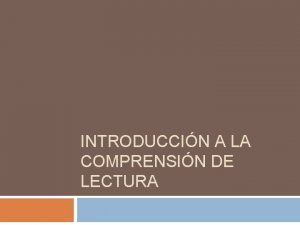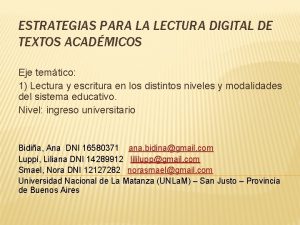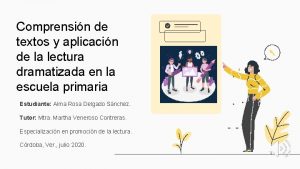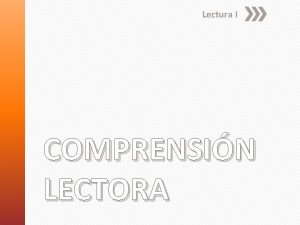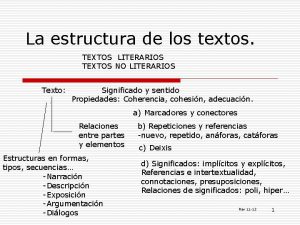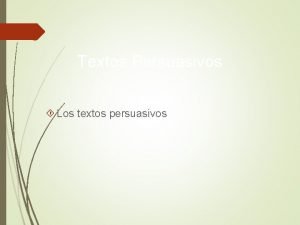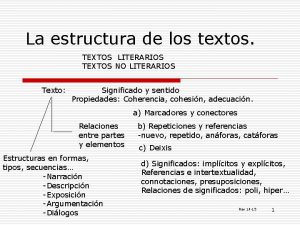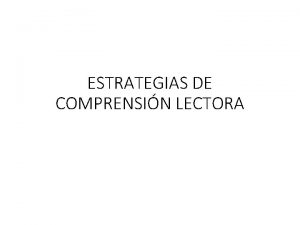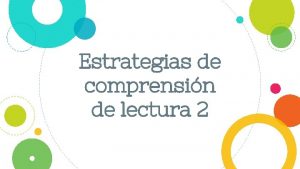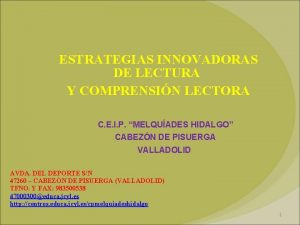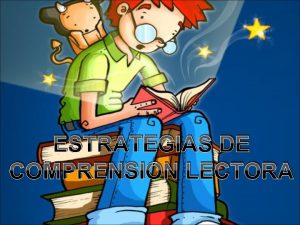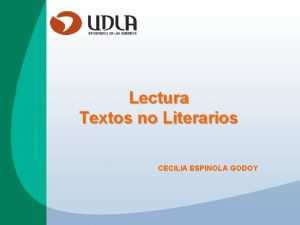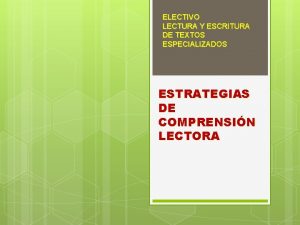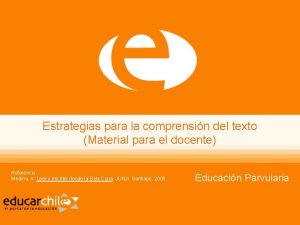Estrategias de lectura para la comprensin de textos

















































- Slides: 49

Estrategias de lectura para la comprensión de textos académicos en Inglés Plan de Estudios: Licenciatura en Lenguas Unidad de Aprendizaje: Inglés para propósitos académicos Unidad de competencia: Ecología. Hacer listas de referencia, composición de una investigación Profesor: Guillermo Romero Hernández

Estrategias de lectura para la comprensión de textos académicos en Inglés Objetivo Proporcionar al alumno herramientas y estrategias que le permitan una mejor comprensión de textos académicos escritos en el idioma Inglés, para las diferentes áreas de conocimiento

Competencias Ser capaz de aproximarse a la lectura de textos académicos en inglés Identificar diferentes estrategias de comprensión lectora en Inglés Ser capaz de aplicar las estrategias a un texto real del área de conocimiento propia del docente

Metodología general de trabajo Lectura de comprensión Tipos o estilos de lectura para abordar textos académicos Estrategias para la lectura de comprensión Factibilidad de las estrategias aplicadas al idioma Inglés Lectura en Inglés Estructuras gramaticales básicas Vocabulario de sintaxis (nouns, verbs, adjectives, adverbs, conjunctions) Componentes básicos de las oraciones en Inglés

Metodología general de trabajo Estrategias de lectura de comprensión en inglés Skimming Scanning Revisión de diferentes estrategias aplicables a textos académicos Vocabulario técnico básico Componentes de cohesión y coherencia en Inglés Aspectos discursivos y comunicativos del Inglés Adquisición de componentes generales de textos académicos (conjunctions, prepositions, connectors, idioms, phrasal verbs)

Metodología general de trabajo Textos académicos reales Selección de textos académicos de acuerdo al área de conocimiento Resolución de ejercicios con asistencia del instructor Resolución de ejercicios a través de equipos de trabajo

What is Reading? “An active, fluent process which involves the reader and the reading material in building meaning” 1 1 Anderson, N. J. (1999). Exploring second language reading. Boston, MA: Heinle & Heinle.

Cognitive processes Decoding Making inferences Critical Reading

SCHEMA THEORY




Schema is knowledge about the topic that individuals have already acquired through various experiences. These experiences and knowledge are activated when reading and can help the reader connect previous experiences to the content of the text.

There are 3 types of Schema Content Schema: previous general knowledge about a topic Linguistic Schema: linguistic information to decode words and their meaning Formal Schema: knowledge about different organizations of text




Cultural and Social Influences on Schema Life at school Relationships Learning English

Basic Linguistics Concepts Noun: the part of speech (or word class) that names or identifies a person, place, thing, quality, or activity. Adjective: a part of speech that modifies (describes) a noun.

Examples of nouns: Common nouns:

Proper nouns:

Adjectives Great Gorgeous Expensive Hideous Tiny

Noun-adjective relationship Adjective + noun That is a really big house Noun + Adjective That is a really house big

More basic concepts Verb: any member of a class of words that function as the main elements of predicates, that typically express action or a state Adverbs: The part of speech (or word class) that is primarily used to modify a verb, adjective, or other adverb.

Verbs can: End in s End in ed Be used along with auxilliary verbs (do, does, did, have, will, would)

Adverbs: Frequency: always, usually, often, sometimes, rarely, hardly ever, never Place: here, there, outside, upstairs, etc. Manner: most adverbs of manner end in ly Quickly, slowly, gently, slightly

Conjunctions The part of speech (or word class) that serves to connect words, phrases, clauses, or sentences. And But Or Nor For Yet So

More conjunctions… After Although As long as Even though Provided that Unless Whereas

Activity Circle the nouns, underline the adjectives, cross the verbs and check the adverbs found in the Reading.

Language structures Statements Subject + verb + object

Questions Question word + Auxilliary verb + Subject + verb + object?

Negative sentences Subject + Auxilliary verb + not + verb + object

Activities: London New Zealand Reading Overview Reading skills 1

Reading Strategies 1. Identify a purpose for reading 2. Use graphemic rules, which is a phonics approach, and consonant and vowel patterns to aid in bottom-up decoding 3. Use efficient silent reading techniques for improving fluency · Don't “pronounce” each word to yourself. · Try to visually perceive more than one word at a time, preferably in phrases. · Unless a word is crucial to global comprehension, skip it and try to determine the meaning through context

Reading strategies 4. Skimming (for main ideas): Skimming is a type of technique that requires fast reading. The reader reads quickly through a text just to get the main idea/ideas. For example, a reader might skim a dialogue in order to see if the opinions of the people involved in the dialogue are positive or negative 5. Scanning (for specific information): Scanning, similarly to skimming, consists of moving quickly through a text, but the difference is that you are looking for specific information. 6. Use semantic mapping or clustering 7. Use inference and guessing 9. Distinguish between literal and implied meanings

Activities The Unexplained What´s the main topic the 3 people talk about? What do each of them think about it? Select a Reading from Reading Skills 1 and develop a graphic organizer Reading Skills 2 Africa

Strategies for learning vocabulary Reflecting When encountering new words in a text, students can sometimes feel overwhelmed. However, there are different degrees of word knowledge. There a number of different stages of knowledge, rather than just an 'on/off' switch for 'knowing' a word.

Student self-assessment tool No knowledge 0 I have never seen the word before. Expert knowledge 1 2 3 4 5 I have seen I understand I have tried to I use the the word but the word use this word, word with am not sure when I see or but I am not confidence in confidence, what it hear it in a sure I am either both in means. sentence. using it speaking or speaking and correctly. writing.

Asking questions about words Are there certain words that often occur before or after the word? (Collocation) (If it is a verb) Is there a particular preposition that often follows it? (Collocation) Are there any grammatical patterns that occur with the word? (Grammar) (If it is a noun) Is it countable or uncountable? (Grammar) Did we study any of the members of this word family? (Word parts) Are there any familiar roots or affixes for this word? (Word parts) Is the word used in both speaking and writing? (Register/Appropriateness) Could this word be used to refer to people? Animals? Things? (Meaning) Does the word have any positive or negative connotations? (Meaning)

Using Word Parts It is important to let readers, know that they can use word parts to their advantage when finding new words. Breaking words into affixes is an excellent way to decode unknown words. However, we need to explain to students that patterns are not absolute rules; they should not think that all endings or beginnings of words are affixes and have the same characteristics. Take for example the word waiter, which means somebody (signaled by the suffix -er) who waits (signaled by the root wait). However, would you say the same thing about the word shoulder?

Adjectives ending in –ed or -ing Las terminaciones "-ed" y "-ing" no sólo se usan para formar los tiempos verbales del pasado y presente continuo, también se usan con adjetivos. Estos adjetivos están compuestos de un verbo y estas dos terminaciones, pero ten en cuenta que el sentido cambia dependiendo de que terminación se use.

Adjectives ending in -ed Los adjetivos que terminan en "-ed" indican o describen emociones. Estos adjetivos suelen acabar en "-ado", "-ido" o "-edo" en español y van después del verbo "estar". Ejemplos: John is interested in art. (John está interesado en el arte. ) Denise was bored in class. (Denise estaba aburrida en clase. ) Luke is excited about his new job. (Luke está emocionado con su nuevo empleo. )

Adjectives ending in -ing Los adjetivos que terminan en "-ing" indican o describen una característica de algo o alguien. A diferencia de los adjetivos que terminan en "-ed", no hay regla en español para formar estos adjetivos y van después del verbo "ser". Ejemplos: John is an interesting person. (John es una persona interesante. ) The class was boring so Denise fell asleep. (La clase era aburrida asi que Denise se durmió. ) Luke started an exciting new job. (Luke acaba de empezar un nuevo empleo emocionante. )

How can we identify if the word is an adjective or a verb?

Idiom: a manner of speaking that is natural to native speakers of a language Every language has its own collection of wise sayings. They offer advice about how to live and also transfer some underlying ideas, principles and values of a given culture / society. These sayings are called "idioms" - or proverbs if they are longer. These combinations of words have (rarely complete sentences) a "figurative meaning" meaning, they basically work with "pictures". This List of commonly used idioms and sayings (in everyday conversational English), can help to speak English by learning English idiomatic expressions. This is a list, which contains exactly 66 of the most commonly used idioms and their meaning.

Some examples A hot potato Speak of an issue (mostly current) which many people are talking about and which is usually disputed Barking up the wrong tree Looking in the wrong place. Accusing the wrong person Cry over spilt milk When you complain about a loss from the past. Let the cat out of the bag To share information that was previously concealed

More examples Once in a blue moon Happens very rarely. Piece of cake A job, task or other activity that is easy or simple. Speak of the devil! This expression is used when the person you have just been talking about arrives. Not playing with a full deck Someone who lacks intelligence

HANDS AT WORK!! Food Challenge Develop own text: Choose a paragraph from your own text, or work with the whole text Apply the strategies seen on the course to get main ideas and specific information Develop a summary or a graphic organizar to share it with the group GOOD LUCK!!

¡THANKS!
 Estrategias de lectura para textos literarios
Estrategias de lectura para textos literarios Comprensin
Comprensin Ideas principales
Ideas principales Significado de mito
Significado de mito Modelos y herramientas para la formulación de estrategias
Modelos y herramientas para la formulación de estrategias Evaluacion y control de estrategias
Evaluacion y control de estrategias Ratoncito dormilon
Ratoncito dormilon Estrategias para abatir el rezago educativo en primaria
Estrategias para abatir el rezago educativo en primaria 5 estrategias para evitar el consumo de tabaco
5 estrategias para evitar el consumo de tabaco Modelo holístico de laframboise
Modelo holístico de laframboise Que son las relaciones interpersonales
Que son las relaciones interpersonales Estrategias para el manejo de conflictos
Estrategias para el manejo de conflictos Que ventajas tiene leer en voz alta
Que ventajas tiene leer en voz alta Lecturas para niños de segundo basico
Lecturas para niños de segundo basico Indicadores para evaluar lectura
Indicadores para evaluar lectura Representaciones de la tierra
Representaciones de la tierra Lectura para niños de 11 años
Lectura para niños de 11 años Texto narrado em primeira pessoa
Texto narrado em primeira pessoa Desarrollo en un texto
Desarrollo en un texto Epigrafe de una noticia
Epigrafe de una noticia Texto informativo exemplo
Texto informativo exemplo Estrategias de trabajo colaborativo entre docentes
Estrategias de trabajo colaborativo entre docentes Estrategias de diversificación
Estrategias de diversificación Estrategias metacognitivas ejemplos
Estrategias metacognitivas ejemplos Estrategias de evaluación formativa
Estrategias de evaluación formativa Metas a corto plazo proyecto de nacion
Metas a corto plazo proyecto de nacion Exemplos de estratégias didáticas
Exemplos de estratégias didáticas Estratégias genéricas
Estratégias genéricas Amenazas
Amenazas Plan de ventas de una empresa de chocolates
Plan de ventas de una empresa de chocolates Iso 22301
Iso 22301 Tipos de acompañamiento escolar
Tipos de acompañamiento escolar Estrategias fo fa do da
Estrategias fo fa do da Champion challenger estrategia
Champion challenger estrategia Estrategias de trabajo colaborativo entre docentes
Estrategias de trabajo colaborativo entre docentes Juegos con estrategias mixtas
Juegos con estrategias mixtas Estrategias genericas de porter
Estrategias genericas de porter Global estrategias
Global estrategias Estrategias de aprendizaje ejemplos
Estrategias de aprendizaje ejemplos Estrategias funcionales
Estrategias funcionales Estrategias de inventario
Estrategias de inventario Acra escala de estrategias de aprendizaje
Acra escala de estrategias de aprendizaje Ejercicio
Ejercicio Disfasia características
Disfasia características Estrategias del ciclo de vida del producto ejemplos
Estrategias del ciclo de vida del producto ejemplos Dimensiones de estrategias
Dimensiones de estrategias Ajustes y estrategias en el juego
Ajustes y estrategias en el juego Mercadocul
Mercadocul Adecuaciones curriculares
Adecuaciones curriculares Tipos de adecuaciones curriculares
Tipos de adecuaciones curriculares
